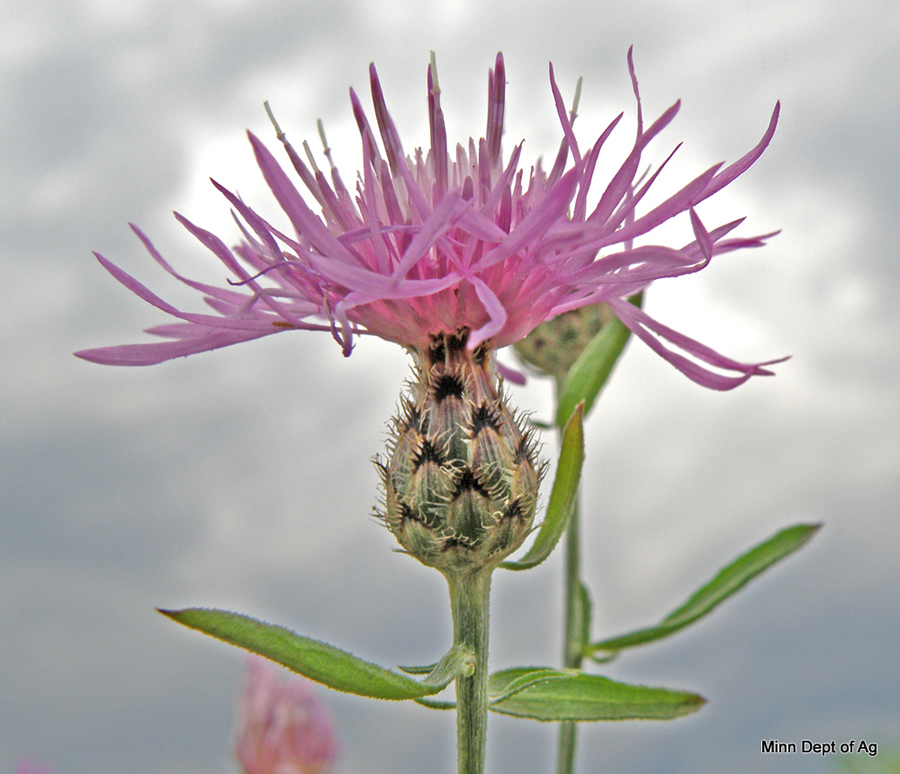Effects of Wildfires in Waterton
In 2017, wildfires broke out in the southern Alberta region. Of the places affected, Waterton Lakes National Park was hit particularly hard. 36.6% of its land being burned in the process [1]. However, another unfortunate side effect persists to the present day. That of the natural balance between the species that live in Waterton. Invasive species that were previously present in Waterton were drastically advantaged by the post-wildfire environment, leading to them growing at concerning rates, harming the natural species in the area [3]. Our team became aware of this environmental issue last year, and thus focused our project around providing a new solution to the issue of invasive plants in Waterton

[1] Kenow fire burn severity map. The burn severity ranges from mild (lime green), to very high (red). Severity corresponds to the change in vegetation. Figure sourced with permission from Parks Canada.
Spotted Knapweed
78.0% of human hours spent controlling weeds are dedicated to Spotted Knapweed (Centaurea stoebe) alone, more than every other invasive plant species combined [4]. Spotted Knapweed is one of the more notable invasive plant species advantaged by the 2017 wildfires. It proves troublesome as one spotted knapweed plant can release up to 1000 seeds over the course of its lifetime[5] and emit allelopathic chemicals that inhibit the germination of native species [5][7]. Through sheer numbers, they take up available nutrients in Waterton, thus starving native species, and their seeds are formidably resilient, staying dormant for up to five years. Also, spotted knapweed is easily flammable. Thus, when a wildfire strikes an area infested with the species the populations burn easily to further exasperate the fire. Which leads to wildfires emitting increasingly more greenhouse emissions to the atmosphere. These factors allow spotted knapweed to overwhelm areas such as Waterton, resulting in its biodiversity decreasing [7] as native species die-of. This is why our team decided to focus specifically on controlling Spotted Knapweed!

[2] Spotted Knapweed plants commonly have purple heads, slim stems, and bristled seeds. Picture sourced with permission from the Minnesota Department of Agriculture.
.
Knaptime is Over
Addressing UN sustainability goals 13 and 15;' Knaptime is Over' is an RNAi-based herbicide targeting Spotted Knapweed. RNAi stands for RNA interferences and is a cellular mechanism that silences gene expression and comprises a vital part of an organism’s immune response [8] There have been previous methods of dealing with Spotted Knapweed. They include manual removal by volunteer efforts, the release of insect predators, and the use of traditional herbicides. However, each of these stated controls has their own problems. For example, manual removal takes up large amounts of labour that could be used elsewhere. The use of insects such as the Knapweed Root Weevil takes time to implement; time that might not be possible to spare. Finally, the use of chemical controls could indirectly harm or negatively affect a handler or surrounding wildlife [9].
Knaptime is Over is able to avoid these consequences as our herbicide employs an RNAi system to selectively target the Clp protease of a spotted knapweed's chloroplast gene, which is vital for its survival. Through careful design, our system would ensure that only spotted knapweed is affected. Using RNAi is also time and cost-efficient. We plan for our herbicide to be easily applicable, decreasing labour expenses.

Overall, the reduction of Spotted Knapweed numbers in Waterton will contribute to restoring its biodiversity. Which, in the long run, leads to a more secure and stable environment for the world. Our method of using an RNAi herbicide can also be transferred to other invasive species by merely switching the target gene. In the end, our team ventures to maintain a biodiverse world for all!
.
References
- [1] Parks Canada. (2021, May 21). Kenow Fire: Burn severity map [Map]. Kenow Fire: Burn Severity Map. https://www.pc.gc.ca/en/pn-np/ab/waterton/nature/environment/feu-fire/feu-fire-kenow/brulage-burn
- [2] Minnesota Department of Agriculture. (n.d.). Spotted Knapweed. Retrieved October 13, 2021, from https://www.mda.state.mn.us/plants/pestmanagement/weedcontrol/noxiouslist/spottedknapweed
- [3] Parks Canada. (2019a, July 16). Play, Clean, Go - Waterton Lakes National Park. Waterton Lakes National Park. https://www.pc.gc.ca/en/pn-np/ab/waterton/nature/conservation/nettoyer-clean
- [4] Kapoor, N. (2019, October 10). Spotted knapweed plant management and restoration of native grassland in Waterton Lakes National Park, Alberta. Lakehead University Library. https://knowledgecommons.lakeheadu.ca/handle/2453/4418
- [5] Pokorny, M. L., Mangold, J. M., Hafer, J., & Denny, M. K. (2010). Managing Spotted Knapweed (Centaurea stoebe)–Infested Rangeland after Wildfire. Invasive Plant Science and Management, 3(2), 182–189. https://doi.org/10.1614/ipsm-09-023.1
- [6] Knochel, D. G., & Seastedt, T. R. (2009). Sustainable Control of Spotted Knapweed (Centaurea stoebe). Management of Invasive Weeds, 5, 211–225. https://doi.org/10.1007/978-1-4020-9202-2_11
- [7] Blair, A. C., & Hufbauer, R. A. (2009). Geographic Patterns of Interspecific Hybridization between Spotted Knapweed (Centaurea stoebe) and Diffuse Knapweed (C. diffusa). Invasive Plant Science and Management, 2(1), 55–69. https://doi.org/10.1614/ipsm-08-105.1
[8] Agrawal, N., Dasaradhi, P. V. N., Mohmmed, A., Malhotra, P., Bhatnagar, R. K., & Mukherjee, S. K. (2003). RNA Interference: Biology, Mechanism, and Applications. Microbiology and Molecular Biology Reviews, 67(4), 657–685. https://doi.org/10.1128/mmbr.67.4.657-685.2003
- [9] Nicolopoulou-Stamati, P., Maipas, S., Kotampasi, C., Stamatis, P., & Hens, L. (2016). Chemical Pesticides and Human Health: The Urgent Need for a New Concept in Agriculture. Frontiers in Public Health, 4. https://doi.org/10.3389/fpubh.2016.00148



